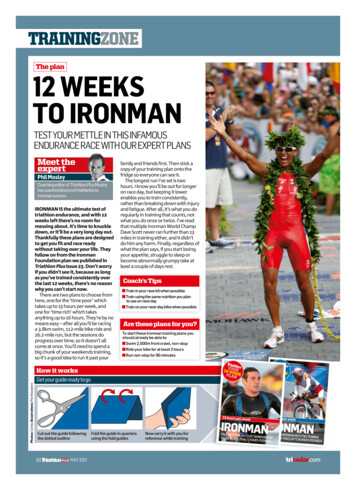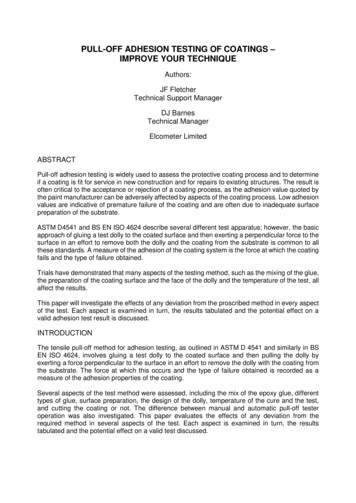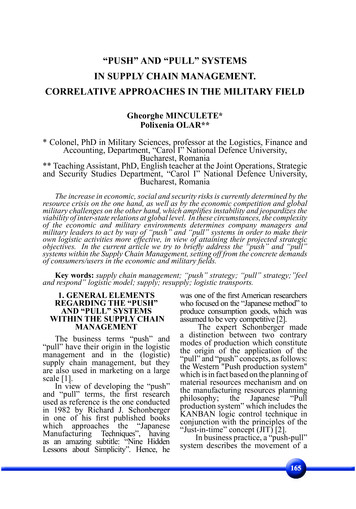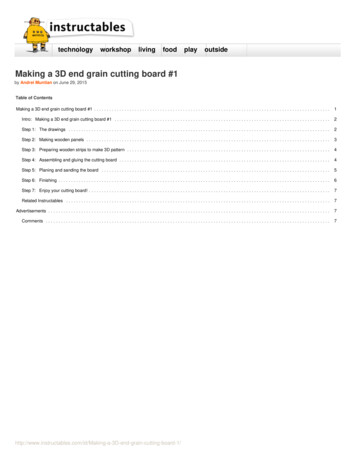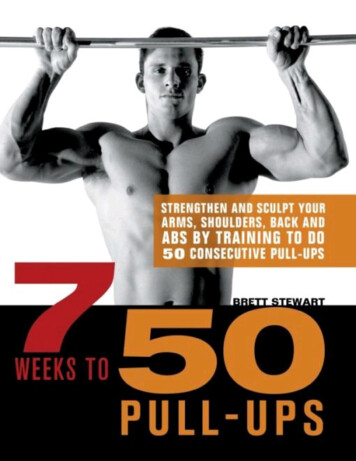
Transcription
Table of ContentsTitle PageDedicationPART I: OVERVIEWIntroductionHow Pull-Ups Changed My LifeAbout the BookWhat Is a Pull-Up?The Muscles behind the MovementWhy Pull-Ups?Pull-Ups in the MilitaryFrequently Asked QuestionsBefore You BeginWarming Up and StretchingAvoiding Injuries12 Tips for SuccessInitial TestPART II: THE PROGRAMSThe 50 Pull-Ups ProgramGrips and Hand PositionsReading the workout charts7-Week Program: Phase IPhase I Test7-Week Program: Phase IIFifty Pull-Up TestPART III: BEYOND 50 PULL-UPSMaintaining Your Physique with Pull-UpsAdvanced Pull-Ups5-Up, 5-Down Pull-upsSide-to-Side Pull-UpMixed-Grip Pull-UpMixed-Grip “Commando” Pull-UpNeutral-Grip Pull-Up with Leg RaiseTowel Pull-UpWeighted Pull-UpHanging Leg Raise90 -Arm Hang with Leg RaiseAPPENDIXIndexAcknowledgementsAbout the AuthorCopyright Page
This book is dedicated to my wonderful wife Kristen, who has put up with all my crazy training and events over the years. Without hersupport, my fitness lifestyle would never be possible.
PART I: OVERVIEW
IntroductionWe all want to be lean, fit and healthy, right? But how can you choose the workout plan that will yield the best results in the least amount of time? Thehardest part of exercise may not even be the workout—it may be finding the time to stick with your new routine.
The great news is that pull-ups are an incredibly efficient way to work your entire upper body and core in less than 20 minutes a day, 3 days a week—with no special training or fancy equipment! You can strengthen and sculpt your arms, shoulders, back and abs by following a progressivetraining program using pull-ups. 7 Weeks to 50 Pull-Ups features that routine—and much more. The routines contained in this book will detail theplentiful benefits of pull-ups, such as vastly improved muscular endurance in your upper body, arms and core, more lean muscle, and a metabolismfired up to burn any excess fat.I’ll say it again: 20 minutes a day, 3 days a week. It’s important that a workout be easy to follow, quick, and show results almost immediately. If anexercise is too difficult to follow or remember off the top of your head, you just won’t stick to it. And if you don’t see results quickly, you’re likely togive it up—like all those other fitness goals and plans that you probably didn’t finish. So, believe me when I tell you that if you follow this program,you’ll feel the results immediately and be well on your way to a leaner, fitter, healthier you.MOST PULL-UPS IN 1 MINUTE (MALE): 50 (TIE)Jason Petzold (USA)June 20, 2009, in Millington, MichiganMatthew Bogdanowicz (USA)Nov. 12, 2009, in Castro Valley, CaliforniaMOST PULL-UPS IN 1 MINUTE (FEMALE): 37Alicia Weber (USA)May 27, 2010, in Clermont, FloridaHow Pull-Ups Changed My Life“Pull-up.” The word alone is enough to scare a middle-school kid in gym class. Throughout school I dreaded each fall when we would perform thePresidential Physical Fitness Test (see page 39). I was adequate at sit-ups, push-ups and even the shuttle run, but I was never able to squeak outeven one pull-up.For years I was afraid to even think about attempting a pull-up at the playground, and, as I got older, even more so at a gym. I used to watch inamazement from the other side of the gym as the fit guys did their sets. I’d secretly count their repetitions—I guess I was a pull-up stalker. Every sooften I’d reach up and grab the pull-up bar and attempt to do one rep. When I failed to pull myself all the way up, I’d make it look like I was juststretching. Call me vain but I really wanted to knock out a set often in front of everyone at the gym. I just never really envisioned that I could actuallydo it.Today, at almost 40 years old, I do anywhere from 50–100 pull-ups at every workout.How did I do it? I stopped wishing I could do a pull-up and started a progressive training program that reshaped my fitness and my life. 7 Weeksto 50 Pull-Ups was created directly from that program. It incorporates routines for individuals of any age, gender and ability who want to take theirfitness to new levels.
About the Book7 Weeks to 50 Pull-Ups is built on a flexible program that can benefit men and women alike. It’s an easy-to-follow progressive training programdesigned to take you from your current fitness level to a level where you can complete as many as 50 pull-ups in one workout. The book providesthree levels that are suitable for everyone regardless of age, gender or ability.Because this type of workout requires you to lift your entire body weight, you’ll need to find a balanced ratio of strength to weight. If your body hasexcess weight, it’ll obviously be harder to perform the pull-ups. The good news is that working through the levels of the program will help you loseweight due to a revved-up metabolism and the growth of lean muscl Sticking with and completing the program at any level will help you build astronger body and sculpt your physique in just 20 minutes a day, 3 days a week.Since the hardest part of any new fitness regimen is the first step, I’d like to save you some time and effort by getting some common excuses outof the way right now.THE EXCUSE: “I’m not going to do pull-ups at a gym—too many people will see me fail!”SOLUTION: Start out in the privacy of your home. Most sporting goods stores have inexpensive pull-up bars that work in a doorway orbasement.THE EXCUSE: “I can’t even do one pull-up.”SOLUTION: You don’t have to be able to do any pull-ups to start. The Prep-Level Program features multiple exercises to prepare you forpull-ups and build your strength and confidence.THE EXCUSE: “This is probably too hard for a beginner.”SOLUTION: Nonsense. These are tried and true exercises that anyone can do, with variations for beginners, fitness professionals, andeveryone in between.THE EXCUSE: “I don’t have enough time in my busy schedule to follow a routine.”SOLUTION: 7 Weeks to 50 Pull-Ups is built around a 15–20 minute workout (with breaks between sets) performed only three days a week.The workout is very easy to integrate into your life. You can even do sets while getting ready in the morning.With those excuses out of the way, here’s what you can expect from this book.PART 1 introduces the program and takes the fear out of pull-ups by explaining the proper form. You’ll learn the health and fitness benefits andthe answers to any lingering questions you may have. The goal of Part 1 is to get you ready for a regimen that will transform your body and changeyour life. The first step consists of preparation, warming up/stretching and taking the initial pull-up test.PART 2 gets you started on the training plans for every age, gender and ability. They’re broken down into Phase I and Phase II. Each level has itsown specific exercise plan and duration, and each level builds on the previous one to help you reach your goal.MOST PULL-UPS IN 30 MINUTES (MALE): 543Stephen Hyland (Great Britain)July 5, 2010, in Surrey, EnglandMOST PULL-UPS IN 30 MINUTES (FEMALE): 398Alicia Weber (USA)Feb. 6, 2010, in Clermont, FloridaPART 3 showcases some alternative workouts that employ different pull-up grips and motions. These alternatives will provide even more impacton specific muscle groups. Part 3 also provides a maintenance plan to keep you fit in between.THE APPENDIX features workout logs so you can track your progress throughout the plan. It also presents warm-up exercises and stretches, aswell as the Prep-Level Program, which is designed for those who can’t yet do a single pull-up.In addition, throughout the book you’ll learn interesting pull-up facts, records and tips on improving your form.
What Is a Pull-Up?The first image that comes to mind when you think of a pull-up is possibly a red-faced drill sergeant screaming in a cadet’s face as he or shestruggles to pull his or her chest up to the bar for one more repetition. This compound strength-training pulling exercise is one of the definingmoments of basic training—and for good reason. Being fit enough to pull one’s body weight up and over obstacles is critically important for asoldier. This level of fitness is important for civilians too.PULL-UPS ILLUSTRATEDPictures of seven pull-up variations from easiest to hardest (left to right)A pull-up is an exercise in which you hang from a fixed bar using an overhand (pronated) grip, then pull yourself up until your elbows are bent, yourhead is higher than your hands and the bar is at shoulder height. This action targets all the major muscle groups of the upper body, requiring themto work together to complete the movement.Pull-ups can be performed using several different hand grips, with each grip targeting certain muscle groups more than others. For instance, anunderhand pull-up (commonly known as a chin-up) recruits the biceps more than the wide-grip pull-up. Our goal is to crank out 50 standard pull-upsin seven weeks.The Muscles behind the MovementThis compound exercise requires that several muscle groups work together and includes movements around two joints (the shoulder and theelbow). When you do a pull-up, you first use the many muscles of the hand and forearm to grip the bar. Strengthening these muscles is important foreveryday tasks, whether you use a computer all day or perform manual labor. You then utilize the larger muscles of the upper arm, shoulders andback:LATISSIMUS DORSI One of the prime movers during a pull-up, the latissimus dorsi (meaning “broadest muscle in the back”) is responsiblefor moving the arm toward the center of the body (adduction), internally rotating the arm at the shoulder toward the center of the body (medialrotation), and moving the arm straight back behind the body (posterior shoulder extension). It also plays a synergistic role in extending andbending to either side (lateral flexion) the lumbar spine. This pair of muscles is commonly referred to as “lats.”
TRAPEZIUS Another prime mover, the trapezius (commonly referred to as “traps”) is a large, superficial muscle located between the baseof the skull and the mid-back, and laterally between both shoulders. Its primary function is to move the scapulae (shoulder blades) andsupport the arm.FOREARM FLEXORS/ EXTENSORS The structure between the elbow and wrist contains a number of muscles, including the flexors andextensors of the digits, brachioradialis (which flexes the elbow), pronators (which turn the palm of the hand downward) and supinator (whichturns the palm of the hand upward). These muscles allow you to grip the bar.BICEPS BRACHII One of the assisting muscles during a pull-up, the biceps brachii (commonly referred to as “biceps”) is responsible forforearm rotation and elbow flexion. It’s located on the front of the upper arm. Note: Chin-ups are more effective at targeting the biceps thanpull-ups due to the supinated grip.TRICEPS BRACHII The large muscle located on the back of the upper arm, the triceps brachii (commonly referred to as “triceps”) isresponsible for straightening the arm. The triceps makes up over 50 percent of the upper arm’s muscular mass.CORE This term refers to the area of the torso composed of the rectus abdominis (the “six-pack” portion of the abdominals), obliques,transversus abdominis, and erector spinae. Full-body functional movements traditionally originate from this area of the body and it providesstabilization during pretty much every activity your body performs on a daily basis, from exercises including the pull-up to maintaining properposture when standing or sitting. A strong core is essential to proper fitness; your body’s strength needs a solid base to work from.DELTOIDS The deltoid muscle is responsible for the much-coveted curved contour of the shoulder and is made up of three sections: front,lateral and rear. Pull-ups, although not a major contributor to deltoid development (besides rear deltoid), are still an ancillary benefit to thismuscle.
MOST PULL-UPS IN 3 MINUTES (MALE): 100Ngo Xuan Chuyen (Vietnam)1988 in “Strongest Soldier in Vietnam” contestMOST PULL-UPS IN 3 MINUTES (FEMALE): 67Alicia Weber (USA)July 28, 2009, in Clermont, Florida
Why Pull-Ups?The pull-up is one of the simplest and most effective exercises you can do to carve up your upper body—back, arms, chest and shoulders—as wellas firm up your core. This exercise that you can perform almost anywhere ignites a complex blend of muscle groups to raise your fitness to newlevels. A simple bar hung over a closet door or a jungle gym at a playground (my favorite) can be used for a muscle-sculpting workout that takesonly a few minutes, three days a week. If you’re looking to boost your strength, muscle tone and overall fitness, pull-ups are one of the easiestexercises to understand and complete.Pull-ups are fantastic for building strength, endurance and, even more importantly, confidence. Overtime, athletes have learned that pull-ups are oneof the quickest ways to strengthen and tone the upper body, arms and abs. Not only is lifting your body weight critical to building a lean, strong andfit body, it’s vital for participation in athletics. All sports require athletes to be strong yet agile enough to play at a high level and avoid injury. Thus,pull-ups are a staple exercise for any athlete.You don’t need to fear the pull-up as I once did. It’s actually a lot easier to do than you think, once you learn the proper technique. This techniqueallows the large muscles of your back, chest, shoulders and arms to distribute the workload. Most people that start the 7 Weeks program tell methat they’re amazed how much they can do when they use the proper pull-up form.Pull-ups are also an exercise that gets respect from most people in the gym. Many people are afraid to do sets of pull-ups in front of others forfear of tiring in the middle of a set. But once you’re able to complete sets of pull-ups, the other gym rats will look at you differently. I’ve actually hadother gym patrons come up to me after a set—some of whom can out-bench me by a hundred poun
07.08.2012 · 7 Weeks to 50 Pull-Ups is built on a flexible program that can benefit men and women alike. It’s an easy-to-follow progressive training program designed to take you from your current fitness level to a level where you can complete as many as 50 pull-ups in one workout. The book provides

